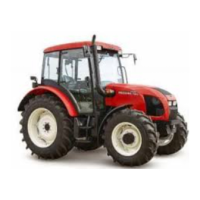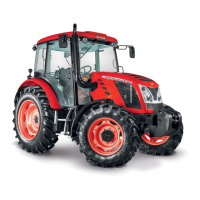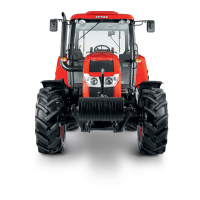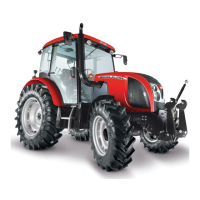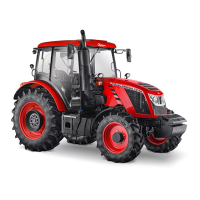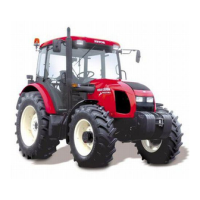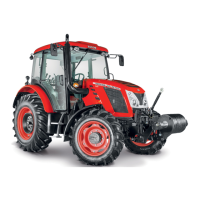
Do you have a question about the Zetor Proxima Plus Series and is the answer not in the manual?
Covers general safety rules, operator qualifications, and proper attire for safe tractor operation.
Details safe engine starting, driving practices, speed limits, and handling slopes.
Provides guidance on transporting vehicles, extricating stuck tractors, and safe procedures for leaving the tractor.
Addresses fire safety, health risks from oil products, and environmental protection measures.
Covers tractor electrical system, noise exposure limits, and driver's seat vibration levels.
Details safety protocols for tractors equipped with front-end loaders and for forest work operations.
Outlines daily checks for fuel system tightness, engine oil level, and cooling system integrity.
Details daily checks for fluid brakes, trailer brakes (air/hydraulic), and hydrostatic steering.
Covers daily checks for tyre pressure, air cleaner maintenance, and cab air filter status.
Describes the operation of cabin doors, windows, internal lighting, and mirrors for user comfort and visibility.
Explains how to adjust passenger seats and the driver's seat for optimal comfort and ergonomics.
Details the operation of the heating, ventilation, and air conditioning (HVAC) system controls in the cabin.
Provides an overview of the steering wheel adjustments, dashboard indicators, and various control switches and levers.
Explains the function and meaning of various warning lights and indicators on the tractor's dashboard.
Details the operation of different selectors, switches, and levers for controlling tractor functions.
Guides the user through the engine start-up process, including troubleshooting common starting issues.
Covers gear shifting, speed control, moving off, and driving on inclines and declines.
Explains the operation of foot brakes, air brakes, trailer brakes, and single/double-hose systems.
Details safe procedures for stopping the tractor, leaving it unattended, and important driving warnings.
Outlines general guidelines for the initial period of tractor operation to ensure longevity.
Specifies tasks and checks required during the first 100 hours of tractor operation.
Describes various hitch types, their adjustments, and mounting procedures for trailers.
Covers methods for coupling single-axle trailers and connecting to other trailers or semi-trailers.
Provides tables detailing maximum vertical static loading and speed limits for various hitch types.
Explains how to safely work with the tractor's output shafts and connect machinery.
Details the engagement and speed selection for both front and rear PTO shafts.
Covers replaceable output shaft terminals and maximum power transfer capabilities.
Introduces the hydraulic system and explains rear three-point hitch control mechanisms.
Discusses the amount of oil taken from outer drives and relevant capacities.
Explains the use and connection of quick couplers and front hydraulic circuit outlets.
Details the hydraulics control panel and the different ways to regulate the inner hydraulic circuit.
Covers hitch lowering speed control and hydraulic system sensitivity adjustment.
Explains position, power, mixed regulation, and control of outer hydraulic circuits.
Describes the electro-hydraulic control panel, element functions, and system activation procedures.
Details hitch operation modes (sinking, transport, stop) and the vibration compensator function.
Lists EHR error signals, their descriptions, and the functions of outer hydraulic circuit control levers.
Covers the rear three-point hitch, its categories, and safety principles during work.
Explains adjustments for pull rods, bracket selections, and front three-point hitch operation.
Details how to change front wheel tread, adjust stops, and set front wheel toe-in.
Covers rear wheel tread adjustment and the mounting of front driving axle mudguards.
Explains the placement and types of additional weights for the tractor's bonnet, hitch, and wheels.
Provides instructions for filling tyres with fluid, chocking wheels, and using non-freezing solutions.
Covers essential battery and alternator service information, maintenance, and charging control.
Details the fuse box layout, function, and procedures for adjusting tractor lights.
Provides a comprehensive list of tractor lamps, their specifications, and locations.
Outlines maintenance tasks required at different operating hour intervals (daily, 50, 100, 500 hours, etc.).
Lists recommended fluids, filters, and lubricants for various tractor systems and components.
Details specific lubrication points for tractor components and information regarding tractor overhaul.
Provides step-by-step instructions for maintaining the engine oil system, fuel filter, and air cleaner.
Covers maintenance procedures for hydrostatic steering, cooling system, brake fluid, and air systems.
Explains tyre maintenance, inflation procedures, and guidelines for tractor storage.
Details procedures for adjusting V-belts and bleeding the tractor's brake systems.
Covers adjustments for foot/hand brakes, clutch, hitches, and dashboard calibration.
Provides detailed dimensions of the tractor and technical specifications for its engines.
Lists permitted maximum axle loading and tyre loading capacities under various conditions.
Details permitted wheel combinations, tractor power output, and tensile force specifications.
Provides tables for forward and backward travel speeds, and output shaft performance data.
Explains how to calculate tractor load limits and related parameters for safe operation.





